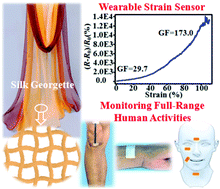Carbonized silk georgette as an ultrasensitive wearable strain sensor for full-range human activity monitoring†
Abstract
The increasing demand of wearable electronic devices has promoted the development of high-performance flexible strain sensors which could monitor various physiological parameters. In this work, using silk georgette, which is a commercially available gauzy and lightweight fabric composed of highly twisted yarns in both warp and weft directions as the raw material, an ultrasensitive strain sensor with a wide workable strain range is fabricated through a facile and large-scale process. The obtained strain sensors exhibit remarkable combined features of ultrahigh sensitivity in a wide sensing range (average gauge factor of 29.7 within 40% strain and of 173.0 for a strain of 60–100%), ultralow detection limit (0.01% strain), high durability and stability (10 000 stretching cycles at 100% strain), fast response (<70 ms) and translucence, which could be ascribed to the unique woven structure of silk georgette. Furthermore, the dependence of the performance of the strain sensors on the woven structures has been demonstrated. Finally, the strain sensors based on silk georgette are demonstrated to show potential for applications in monitoring full-range human activities including both vigorous motions and subtle motions.



 Please wait while we load your content...
Please wait while we load your content...